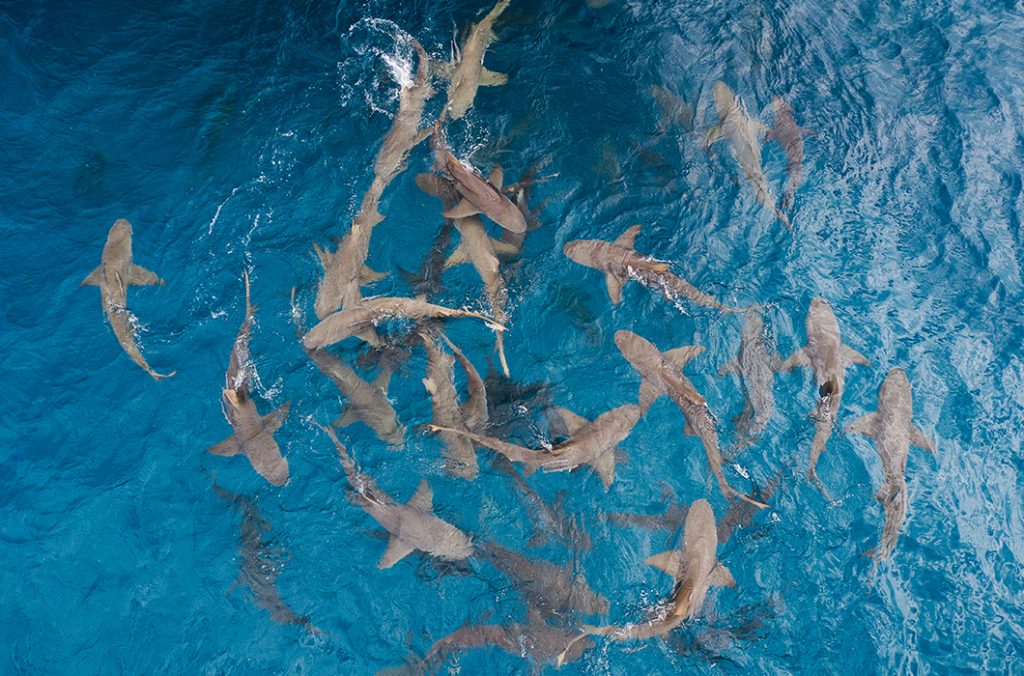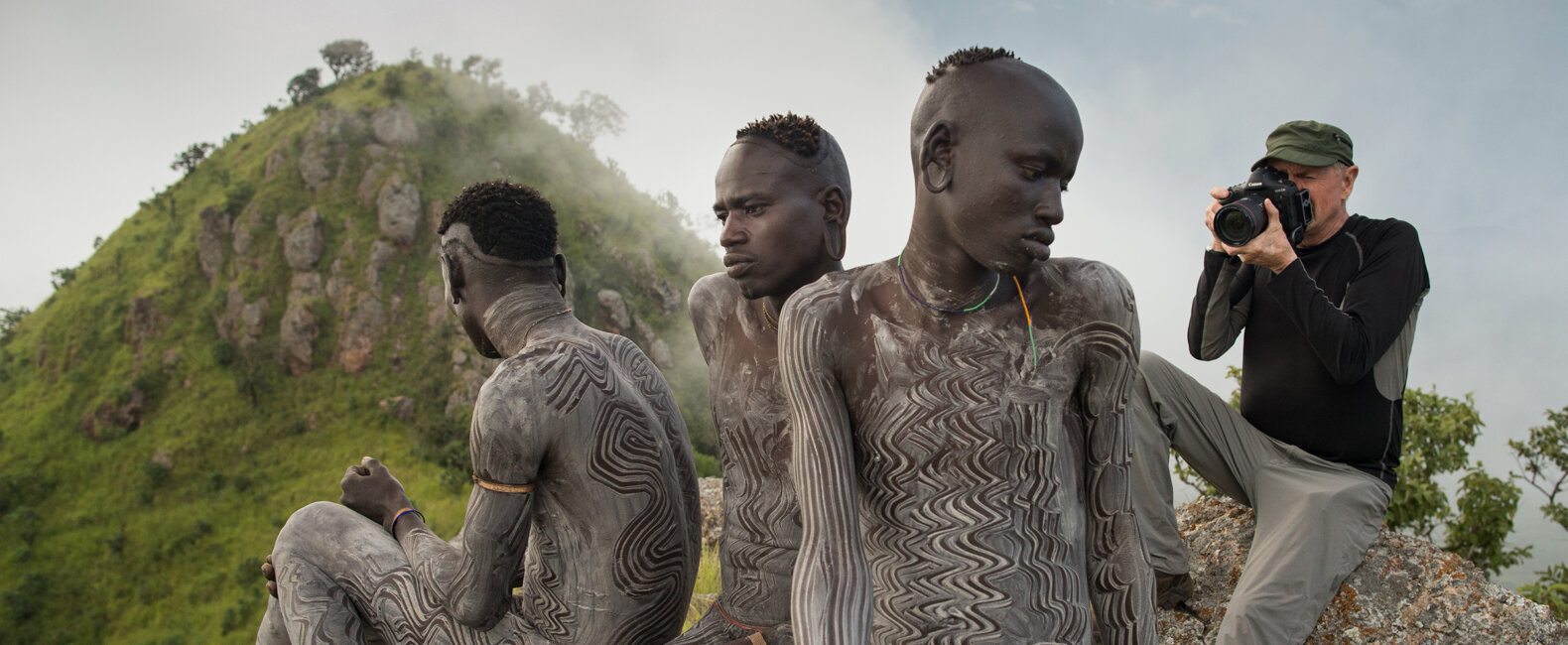There are two stories behind every photograph: the story of what was being captured, and the story of capturing it. Tales by Light, now streaming on Netflix, focuses on the latter, documenting the wild, often perilous journeys of world-class photographers as they create their spectacular images. As you’d expect, making this show was hard ⎯ really hard ⎯ taking cinematographer Abraham Joffe and his team to some of the most dangerous places on earth, including shark-infested waters in the Bahamas, and anaconda-infested rivers in Brazil.
“The trick is to play the odds,” Abraham told us. “Give yourself the best possible chances…then hope for that luck factor — the chance that you’ll encounter something spectacular.”
The odds, it seems, were in Abraham’s favor. Tales by Light is not only visually stunning, but it also tells the types of focused, engaging stories that attract a large, dedicated audience. Which is probably why Tales by Light already has the green light for its second season.
We talked to the show’s creator ⎯ and Filmsupply filmmaker ⎯ Abraham Joffe, about how he these mini masterpieces came to life.
Musicbed: How did you come up with the idea for Tales by Light?
Abraham Joffe: I had been working for Canon Australia for a few years, shooting short-form online content for them. They asked me to shoot some profile pieces of Canon Ambassadors in Australia, and the first one was of underwater photographer Darren Jew. Initially, they wanted a head-and-shoulders interview with some photographs overlaid. Very standard. I said, “Well, guys, we can do that. But I reckon if you cover my flights, I’ll go to Tonga and film him diving with humpbacks.” So we ended up shooting for nine days and came away with this six- or seven-minute piece that was one of the most successful bits of content they’d ever made. I think people were inspired by actually seeing this guy in the water. So after that, I went to the big boss at Canon and pitched the idea of turning this into a series. Showing what it takes for photographers to get the shot. He goes, “What if we took that idea but made it for TV?” So basically he was on board immediately.

How did you choose the projects for these photographers?
We went to them and said we wanted to shoot projects they were interested in. We didn’t want to do the same thing they’d done a hundred times before. You get the best reactions from people when they are in awe of doing something new. Getting a new image. Telling a new story. I think that’s why we ended up doing such amazing stuff in this series. We filmed in the burning ghats in Varanasi. We dove with tiger sharks in the Bahamas…without a cage. Crazy moments. Experiences we couldn’t get doing any other job.
How long did it take to shoot each episode?
We spent about a month shooting each hour-long episode. Sometimes we had really productive days. In Varanasi, we spent three and a half days shooting in the ghats, which ended up being 15 minutes of that episode. A third of the episode, basically, in just three days. Then we spent a week in the Serengeti and used only about a minute’s worth of footage. Seven days for a minute. So it varies. You try to be as productive as possible, but it’s documentary. There are unpredictable factors.
The trick is to play the odds. Give yourself the best possible chances. You pick the best season of the year. You hire the best crew. You get the best local guides. The best vehicles. You put all the best bits into place and then hope for that luck factor — the chance that you’ll encounter something spectacular. And you never know when that’s going to happen. That’s why being able to react is such an important factor.

Obviously I want spectacular imagery, but what’s more important is a well-crafted, well-covered story.
For example, in Brazil we were diving with anacondas in the river. I’ve never done that before, so this was all new. Within 30 minutes of our first day on the river, we came across this massive snake. We hadn’t even gotten into the water yet. We’d just traveled halfway around the world and hadn’t even tested the gear, but we had to jump straight into it. It’s moments like that when you really have to know what you’re doing. You can’t learn on the job. Sometimes you don’t have a second chance. That was the biggest snake we saw in six days, and we saw it within the first half hour.
There are so many amazing moments. Jaw dropping. My uncle always said, “If you find something interesting, chances are a lot of people will find it interesting too.” So we just let ourselves be ourselves during the shoot. We let ourselves be amazed. Let our jaws drop to the ground. And then we tried to translate that to the camera.

What did you learn from documenting these photographers on this project?
One big thing I learned is how important it is to have great people skills. Most of these photographers are quite humble, approachable people. That’s a huge factor. When people like you, they open their doors for you. And they also feel this obligation to leave a great impression for the next photographer who comes along behind them. If you do the wrong thing — if you do something selfish just to get the shot — then you really screw it up for everyone else.
Another thing I learned is that it’s easy to look at these incredible photographers and think their photography is perfect. But I soon realized that everyone, even these guys, is just putting out their very best polished work. In real life, they’re devastated by the shots they miss. Their camera is on the wrong setting. They’re in the wrong spot. The shot is gone and they’re devastated. I’ve felt that way too. Everybody feels that way at some point. You have to keep getting out there. You have to be hungry for these shots. You can’t be matter-of-fact about this job. You have to have that drive to get up early in the morning and shoot the sunrise. Sometimes we missed shots just because we didn’t have the stamina to wake up early. Later on you regret that. But it’s a funny game. You have to manage your fatigue level while still trying not to miss shots.

How many shots do you miss for every one you capture?
Well, it’s a bit different for filmmaking than photography. Obviously I want spectacular imagery, but what’s more important is a well-crafted, well-covered story. We need to make sure we have story content, even if that means getting slightly less spectacular imagery. People aren’t going to remember particular shots in a film. They’re going to remember a great story.
How do you structure episodes made for TV like this?
First of all, you have to have a purpose in the story. You need to know the goal of the story. In this case, the goal was to get particular photographs. But there also needs to be an overriding central theme you can return to when things aren’t going right. You’ve got to have a theme that guides the ship. If you know your goal and your theme, then even when things go wrong — as long as you’ve captured reactions and emotions related to that theme — you’ll have material you can use.
Early on, I used to not shoot failures very much. Now I realize that documenting failures is what makes these projects. When things don’t go right. When frustrations boil over or there are roadblocks. You have to shoot that stuff! As annoying as it is when things get in the way of your goal, the journey is always the most interesting thing. If you focus solely on the end goal, you’ll miss the whole point.
Then, when you’re out there, you have to ask a lot of questions. You have to always be curious. You have to get reactions as they’re happening. I’ve evolved and moved away from shooting sitting interviews. I want to get reactions in the field. You can’t re-create that. You have to have the cameras rolling as you enter a situation. There’s only one chance to capture a first-time reaction. You’ll never get that same reaction again. That’s why we never capture a place for the first time with a drone shot. You don’t get any emotion that way. We start close, then we work wide.
Can you give an example of this goal/theme structure?
One good example is Stephen Dupont’s episode of Tales by Light. It ended up being a very personal journey for him. He’s a war photographer who’s spent the last 25 years photographing death. He’s seen horrific stuff. My biggest question for him was how has this affected him. And it turns out it’s affected him a lot. He told me he sometimes doesn’t sleep at night. So when I asked him what he wanted to do for the episode, he said he wanted to find out if it was possible for him to see death in a new way. That became our theme. The goal was to capture these photographs, but the theme was seeing death in a new way.
We ended up going to Namibia to see the industrial death of a town. We saw death in nature. We shot with the Kalahari Bushmen, the oldest culture on earth. When they pluck a root from the ground, they cut off a bit of their own hair and bury it to give thanks for the plant. It was a real journey, and I think the first time all of those subjects have been put together in one film.

How do you find out about these places? Are you on Reddit constantly?
I keep a lot of notes. Sometimes I find things on Reddit or in a BBC News article. But I also bought every copy of National Geographic magazine from 1955 to today. You can still find interesting things and places in there that haven’t changed very much.
What’s your advice to someone who wants to do work like this?
Work like this is 80 percent about being there. Just getting there. That’s the big hurdle. Get yourself to the location. Once you’ve done that, you’ve achieved most of it. Then it’s just about constantly improving yourself, constantly pushing yourself. We’re always training, doing dive courses, getting new certifications. We all became drone certified in Australia. You want to be able to look back every year or two and go, “I’ve stepped it up a notch.” You never want to reach your peak. You always want to be climbing.
The first season of Tales by Light is now streaming on Netflix. You can also license Abraham Joffe’s footage from our sister company Filmsupply here.
Photos courtesy of Abraham Joffe, Eric Cheng, Stephen Dupont, and Jonathan and Angela Scott.


















































































